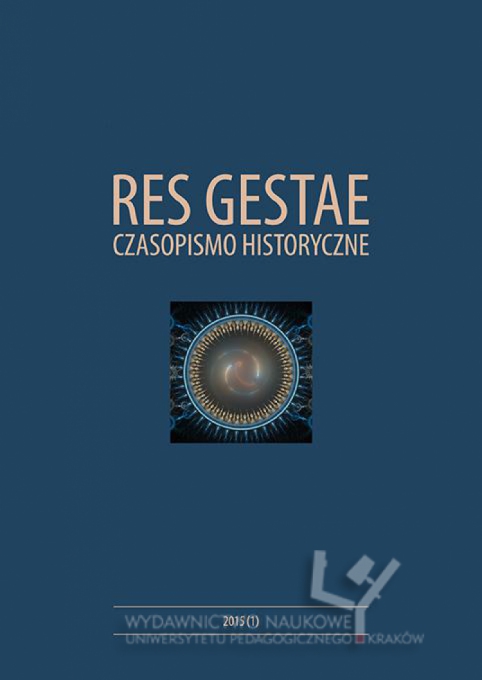
We kindly inform you that, as long as the subject affiliation of our 300.000+ articles is in progress, you might get unsufficient or no results on your third level or second level search. In this case, please broaden your search criteria.

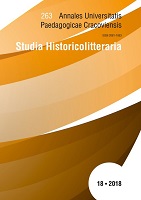
In my article I reconstructed the picture of literary and theatrical Cracow in the years 1918– 1939, represented in the memorials Młodości mej stolica. Pamiętnik krakowianina z okresu między wojnami (the extended edition, 1984), written by Tadeusz Kudliński. The author was an active participant of the cultural life of this city and a bystander of the great social and historical changes after Poland regained its independence in 1918. I tried to confront his subjective view of the important artistic events and processes in the interwar period with the objectivism of historical studies. Kudliński presented a complete and detailed image but, naturally, he paid more attention only to some facts, disregarding or briefly mentioning others. I wanted to understand the motivation behind thematic selection of the material. In the first part of this article, I analysed Kudliński’s „gallery of the portraits” of Cracovian writers and theatre people, paying special attention to the applied genre convention and description method. In the second part, I presented some individual elements of the literary Cracow panorama: professional organisation and institutionalisation of the literary life, the functioning of the publishing market, the development of local newspapers and periodicals, the financial situation of the writers and the meaning of tradition and avant-garde. In the third part, I reconstructed the image of the theatrical Cracow and the author’s views on the philosophy and aesthetics of the theatre. My main objective was to show the great documentary value of Kudliński’s memories – due to their factographic credibility and variety of content Młodości mej stolica can be a valuable source of knowledge about the history of Cracow.
More...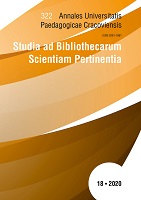
This article analyzes the publishing movement in Krakow from 1919–1920. In that period, 348 titles were published in Krakow, primarily by professional publishers. These were mainly publications in the field of humanities and literature. A large amount of journalism was also published on the topic of current political and social issues. A significant decrease in the number of titles was noted compared to the years before the First World War, mainly due to the lack of paper and its high price, as well as the significant increase in printing costs. This affected the publishing practices in all publishing centers. In addition, as the capital of the reborn state, Warsaw attracted writers and scholars who published their works there instead of in Krakow.
More...
During the successive occupations (Soviet, Lithuanian, German and again Soviet), Wilno was one of the most thriving publishing centers of conspiracy press. Between 1939 and 1945, there were probably 54 press titles published by ZWZ-AK, Regional Delegation for Wilno, Wilno Democratic Concentration, political parties, communist underworld, youth organizations and even individuals. Furthermore, there are 24 known conspiratorial pamphlets published at the time. The military and political undergrounds became the most important publishing focal points for conspiracy press. However, there were also publishers from outside this group – political organizations that did not answer to central authorities, independent groups of a military character, large numbers of youth organizations, individuals issuing underground newspapers. These publications are both a historical source of the Polish armed struggle against the occupant in Wilno and neighboring areas, mostly populated by Poles at that time, and a testament to the debates on political topics within the conspiracies.
More...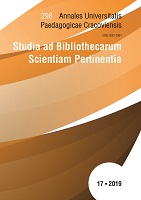
The fate of Polish refugees in Hungary during World War II is little known and poorly researched. Information on this subject comes mainly from memoirs and other unscientific, episodic publications. The exception are texts about the history of the Polish emigre press, whose history began on the Danube during the September Campaign. This is an important fact because in the common consciousness, the emigration press of that period is more often associated with titles published much later by the Polish government in exile in London and emigration circles in Great Britain.
More...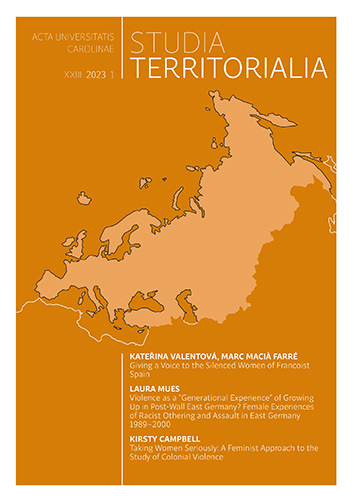
During the Spanish Civil War and the Francoist dictatorship that followed, women were shielded from the public eye. Their predetermined social role was that of submissive and devoted wives to their husbands as well as homemakers and childcare providers. There are few artistic works that suggest otherwise. However, during the Civil War and after, many women were in fact politically active. They occupied important positions in the resistance and were present along with the men in the trenches. Spanish graphic novels have managed to create many works of fiction based on the Civil War, mainly drawing on (auto)biographical accounts. There are so many significant works dealing with the war and Francoist repression that they represent a genre of their own. Nevertheless, the authors of these works, as well as their main protagonists, are usually men. This is true despite the fact that after the war, during the four decades of the Franco dictatorship, many women suffered from political persecution. The aim of this article is to analyze the role of women outside the domestic space as it appears in selected graphic narratives set in the period of Franco’s regime. Given the extent of the regime’s repression, these works are frequently set in the prisons around Spain where female prisoners were incarcerated and tortured. The narratives we analyze are based on real testimonies from real victims. Their individual experiences are joined together in a collective whose voice has long been silenced until recently.
More...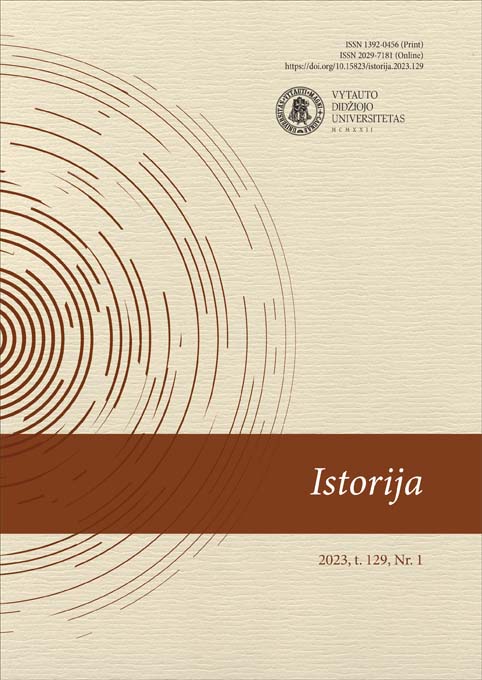
The article, drawing on the primary sources and scientific and popular science publications, presents and examines the life path of an extraordinary personality – Aloyzas Valušis – a scout, an officer of the army of the Republic of Lithuania, a cavalryman, a colonel of the General Staff, and a personal adjutant of the President Antanas Smetona. The aim of the study is to overview the life of Valušis, as well as the reasons and circumstances that shaped him as a high-ranking officer and Lithuania’s representative in the diplomatic service in the position of military attaché. The article discusses the family of Valušis, his youth, service in the Lithuanian army, experiences in the diplomatic service, his social activities and fate as an emigrant. The main stages of Valušis life, which formed a colourful portrait of this personality, are depicted.
More...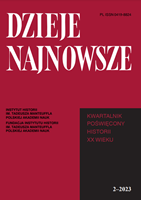
Usually, American presidents’ wives enjoyed their compatriots’ affection. Some played signifi cant roles in their spouses’ administrations, although in a formal legal sense, they had no state responsibilities. The evolution of their roles and the increasing public activity of many of them, particularly in the 20th and 21st centuries, have resulted in lasting changes to the American presidency. In the diverse pantheon of American female presidents, President Woodrow Wilson’s second wife, Edith Bolling Wilson, holds a special place because of her unprecedented role in her husband’s administration. This article aims to provide an overview of her activities as First Lady (from December 1915 to March 1921), with a particular focus on her role and enormous infl uence on presidential decisions and American politics from the autumn of 1919, i.e., during Wilson’s illness.
More...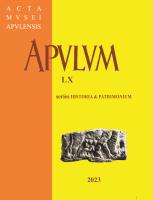
The article presents a new foray into the biography of Ovidiu Gritta. He was involved in the organisation of the National Assembly of 1 December 1918, which decided the union of Transylvania with Romania. Subsequently, during the interwar period, he was in charge of police headquarters in several important Romanian cities, serving for a period as prefect of Turda County. The author of this article has dedicated several studies to him in recent years, and now presents a series of new information relevant to the biography of this character. For example, an unknown episode is that of the trial in which he was involved in 1908 and as a result of which he was sentenced to six months in prison (non executed, in the end) by the Hungarian state for an article published in the Romanian magazine Țara noastră. Another interesting episode presented in this article is that of his seizure in 1924, while he was at the rectorate of the University of Cluj, as head of the local police, after he had put down an anti-Semitic demonstration of Cluj students. Finally, no less interesting is a letter written by a fellow prisoner (Ovidiu Gritta was imprisoned after the Communist takeover of Romania), which speaks of Ovidiu Gritta's personality and condition shortly before his death.
More...
Gârbova (Urwegen), an ancient settlement with resonance for the history of Transylvania, occupies a distinct place in the assessment of the two inhabiting communities: the Romanians and the Saxons. The present article analyses only a few cultural aspects, selected from press reflections or partially placed in works by the author. The scholarly approach seeks to complement, possibly, or underline the decisive role played by the Transylvanian Association for Romanian Literature and Culture of the Romanian People in raising the civic awareness, as well as the cultural level of the Transylvanian Romanian countryside. Revealing the presence of Astra in Gârbova in the 20th century – in a settlement that in 1910 had 434 houses and 1874 inhabitants – we present a possible case study whose characteristics support the exceptional effort of enlightenment through the education of the people (adults, post-school).
More...
Based on a unique book of graphic sketches and notes of Traian Achim (1885-1945), former drawing teacher at the ”Mihai Viteazul” High School in Alba Iulia, in the years 1919-1945, several unique events from his biography and didactic, artistic activity (including domestic, family) can be reconstructed from 1928, until February 4, 1929 (when his notes stop, because the pages of the notebook end). Thus, what was known from the testimonies of the teacher's daughter-in-law, the late Mrs. Valentina Achim, is confirmed, namely the fact that Traian Achim himself designed (making a detailed plan, in our opinion), both the family house, on Moților St., and the building of his artistic workshop, in back of the courtyard, both of which, now, in the light of new information, can be dated with certainty to the year 1928. We can also admit, at the same time, that this year the artist also created the mural depicting Horea, Cloșca and Crișan, from a niche of the Maieri I Orthodox Church in Alba Iulia, a work unfortunately covered during a recent repainting of the mentioned place of worship. He was very concerned, including during the classes he taught at the high school, in his final years, with the ways of graphically representing the different mental states of people, being a lecturer and connoisseur in detail of some European scientific and artistic works on physiognomy or arts decorations, which the teacher had assimilated, reading them either in German or in French (which he knew very well). It is noted that, during that year, he held private shorthand typing courses with over 25 students, recruited from among the most important families of the town, of different ethnicities and occupations, etc. The same artist created the project of the painting for the graduates of “Mihai Viteazul” High School, the 1928-1929 class, and it is believed that he was usually the one who designed this type of artistic-craft work, for several series of graduates. He took care of his family (including the garden of the new house, built in 1928) and created, we believe, several oil paintings on the theme of family life, the concept of which can be found in the pages of the notebook. The artistic value of his sketches is not out of the ordinary, but not entirely negligible, anyway, the artist creating his modernist style of representation (which, perhaps, was not and still is not to everyone's taste), but it denotes professionalism and passion for his job (and his artistic concerns).
More...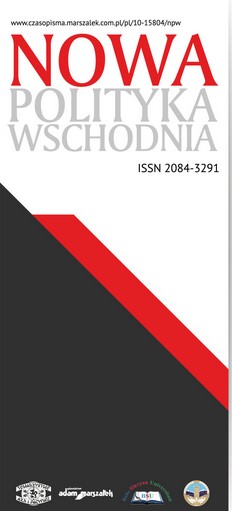
The question of European integration in the political thought of the peasant movement in Central and Eastern Europe appeared many times since the second half of the 19th century. In the period of partitions, people searched for paths to freedom and independence. The ideas of creating multinational political organisms were to be means for obtaining a certain degree of subjectivity. Poles saw development opportunities in the federation within the Habsburg monarchy. On the other hand, the union of the peoples of the former Polish-Lithuanian Commonwealth, mainly Lithuanians, Belarusians and Ukrainians – there was an apparent chance joint struggle with the Russian invader. The geopolitics of the region, constructed in the result of the First World War, meant that the newly created Central European states found themselves between Germany and Russia – both of which were states with imperialist traditions. The question of the union of states, or mainly peasant parties in the political thought of the Polish and European peasant movements appeared several times, but in the 1930s it was rather an addition to the programs of these parties. Initially, the Poles sought an agreement mainly with neighbours facing similar threats. When the implementation of these plans failed, their programs contented with peaceful international cooperation based on the League of Nations.
More...
The article is a two-part law and historical sketch that presents the organization and outline of the activity of the field judiciary during the decisive events in the war with Soviet Russia in the summer of 1920. In this part of the article the author presents an outline of the organization and the activity of the field judiciary since the beginning of its existence to the beginning of July 1920. The justice service of the Polish army came into being as an integral part of the armed forces alongside with the creation of different departments and services of the Ministry of Military Affairs and the General Staff of the Polish Army in the autumn of 1918. The military courts were created since the first days of November 1918 in Cracow, Lublin, Warsaw and Cieszyn, while in Przemyśl and Lviv – since the end of November. In January 1919 the field courts were created at the commands of the great units of the Lithauanian-Belarusan Front. As a separate structure, the field judiciary came into being in spring of 1919 and was part of the High Command of the Polish Army. Until September 1920, at the commands of large units and operational formations (divisions, brigades, operation groups, armies and fronts), as well as commands, garrisons and strongholds, about 60–70 field courts and several judicial and legal departments were created. Field courts played a subordinate, although important role in the command system of large units and operation formations, and in keeping the discipline and internal cohesion of the army.
More...
In October 1920 the military actions of the Polish–Soviet War came to an end. The exhausted Polish army faced demobilization and reorganization. The Air Force also had to adapt to service in the time of peace. Major pilot Stanisław Jasiński expressed interesting ideas concerning the peace organization of the Polish army already at the end of 1920. He saw the necessity of quantitive and qualitative expansion of the Polish Air Force. He believed that there should be at least 24 squadrons in the Polish Army. He also called for setting up 10 additional squadrons for fighting cavalry. In his deliberations, Jasiński did not omit technical and personnel issues. He considered it essential to bring from France and Italy the planes that had been bought there earlier, as well as to purchase additional fighter planes. Moreover, he put forward training over 400 officers and non-commissioned officers to become pilots, battlefield observers and air gunners. What is more, he saw the necessity of moving 1500 soldiers to air service schools. Jasiński’s interesting ideas were never implemented, however. Even the minimum plan was not carried out.
More...
The Border Protection Corps (1924–1939) was a special military formation created to protect the border and ensure safety in the Eastern borderlands of the Second Polish Republic. The BPC soldiers protected borders with the USSR, Lithuania, Latvia, and since 1927 also sections of borders with Romania and Germany, as well as with Hungary in 1939. In March 1927, the BPC Military Police Battalion was established within the structures of the unit. Platoons were created at every brigade or regiment, and a military police post – at every battalion. The main task of the MP was military and police service for the units and soldiers in the area protected by the BPC, as well as in the area where the units where quartered – so as to keep order and discipline. In the unit’s area there were garrisons of the BPC as well as mixed garrisons where Polish Army and even Navy units were also stationed. In August 1927, in the area controlled by the post at the 17th Battalion of BPC in Dawidgródek, incidents involving seamen of the Pińsk Flotilla took place. Reports of the BPC military police kept in the Archives of the Border Guards in Szczecin became the basis of the article devoted to the discipline level of the seamen of the flotilla and their wrangles with the BPC military police.
More...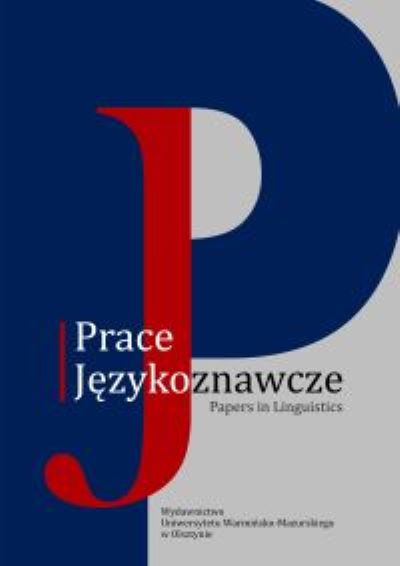
The use of personal names by Soviet Germans remains virtually unexplored. The authors excerpted anthroponyms registered in the 1920s and 1930s from the dictionary of names of Alma-Ata Germans. The material sample contains 75 male and 107 female names. It reflects the state of German anthroponymy, since Germans came to Kazakhstan mainly from the colonies of the Volga and Novorossiya, so they represent members of old communities of colonists. It was found that in the analysed period they chose mainly names used in the German ethnic area (Бертгольд, Гильда), including – less frequently – double names (Петр-Макс, Ильза-Гертруда), which constituted more than 80% of the names. More than 10% of the material consisted of Slavic names (Радомир, Людмила), and only 2% were Central Asian names (Сергазиз, Аниль). This shows that Soviet Germans slowly opened to other communities. Namesake Sovietisms are represented by four male names (e.g. Радий from the name of the chemical element radium, Рем – an abbreviation from революция, электрификация, механизация) and three female names (e.g. Сталина).
More...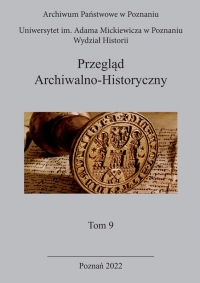
The evolution of scientific institutions in Germany in the second half of the 19th century and the early 20th century brought about the establishment of a professional archive gathering previously dispersed resources on the history of Jews in the German territories. Gesamtarchiv der deutschen Juden was officially launched on October 1, 1905, and soon became the largest and the most important Jewish archive in Germany. The turbulent history of the collection during the times of the fascist regime and in the years following the Second World War caused the original collection to be scattered, while many archival materials were completely destroyed. The article presents parts of the preserved lists of archival documents regarding Jews in Greater Poland that were prepared at the moment of their incorporation into the Gesamtarchiv der deutschen Juden.
More...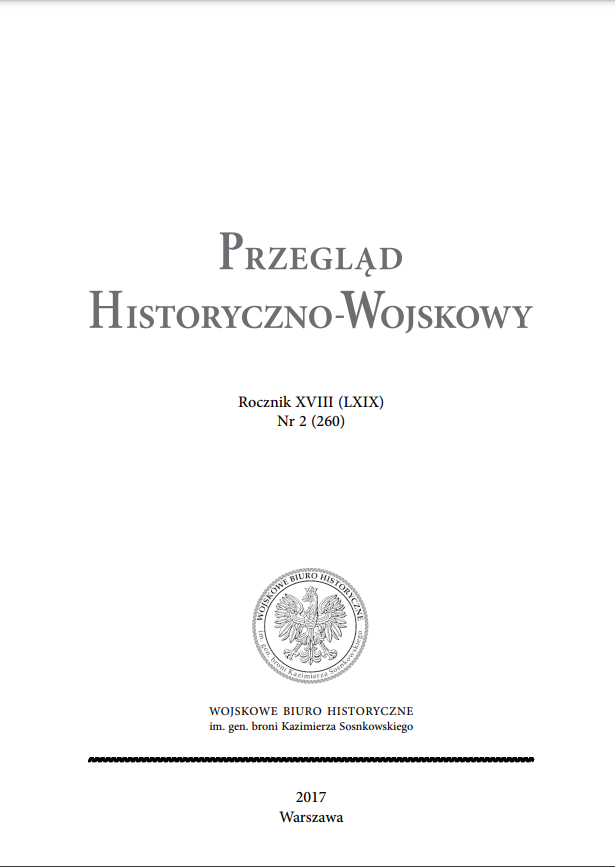
This paper presents the development and tasks of the Armament Service (AS) in the Polish Army. The main aim of the article is to describe the development of the AS since its formal establishment in 1918 up until 1939. The first part of the paper describes the tasks and development of the Armament Service structures within the artillery. After that the organizational development of the AS and the choice of its field of action in the interwar period up until the outbreak of World War II were presented. The development of the service has been shown on the example of its central unit in the Ministry of Military Affairs – the Technical and Artillery Department, Artillery Department, the Department of Artillery and Weaponry, and the Department of Weaponry, as well as its subordinated service units on the level of Corps District Commands, depots, workshops and military units. Moreover, the article presents the role and tasks of the AS related to securing the appropriate use of equipment, its repairs, maintenance, storage and delivery. Then the most important tasks related to formulating regulations on the use of military equipment in the Polish Armed Forces were indicated.
More...
In the interwar period the 63rd Infantry Regiment was stationed in Toruń and constituted a part of the 4th Infantry Division deployed on the area subordinate to the Corps District Command number VIII with headquarters in Torun. The article concerns the most important events connected with the course of military service in the regiment at the beginning of the second half of 1930s. It has been based mainly on a thorough and detailed analysis of the orders of the day from a 3-year period. It presents important events from the soldiers’ life, from conscription onwards. It also describes the oath of enlistment ceremony, the recruits’ religious life, daily schedule, additional trainings for conscripted and professional soldiers, punishments and bans, awards and recognition for service, participation in holidays and in secular and religious ceremonies. The paper acquaints the reader with the barracks life in time of peace and with the course of service in the discussed period. It also shows that during the service the military authorities not only put emphasis on strictly military and physical preparation but also recognized the need of raising a citizen and a conscious defender of the country.
More...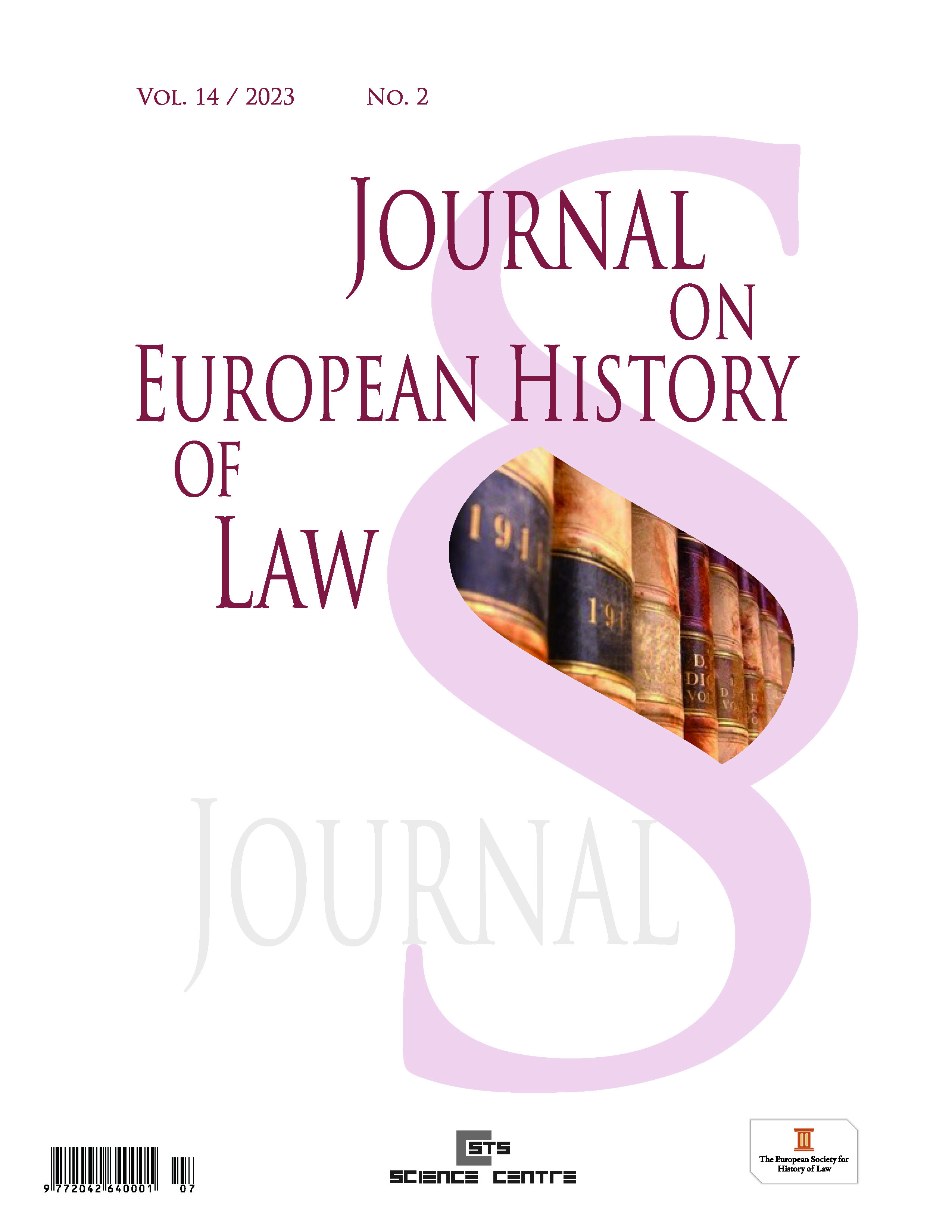
At the very beginning of the twentieth century, during the period of heightened endeavours for the codification of the private law in Hungary, not only the influence of the “great” civil codes (BGB, ABGB, ZGB) was observable. This paper aims to demonstrate the special impact (or, unique renaissance) of the English equity doctrine of undue influence, among the invalidity rules concerning juridical acts, contracts or testaments. Since this examination cannot be carried on separately from scrutinising the legal thoughts and legislation on immoral and usurious contracts, after some general remarks, this work deals with relevant issues of the Hungarian legislation of usury, independently of civil code drafts or embedded into them. Then, it demonstrates the emergence of the undue influence doctrine in the academic discussion, in the civil code drafts and parallelly, in judicial practice. At this point, we should highlight the special interplay between these “sources of legal thinking”, and as a consequence, how the approach to the notion of undue influence was forming in that period, alongside the draft texts (from the year 1900) up to the Proposal for a Private Law Bill (Private Law Bill, 1928). Although this writing focuses on invalidity issues of contractual transactions, one chapter is dedicated to showing the development of the concept of undue influence relating to testamentary dispositions.
More...